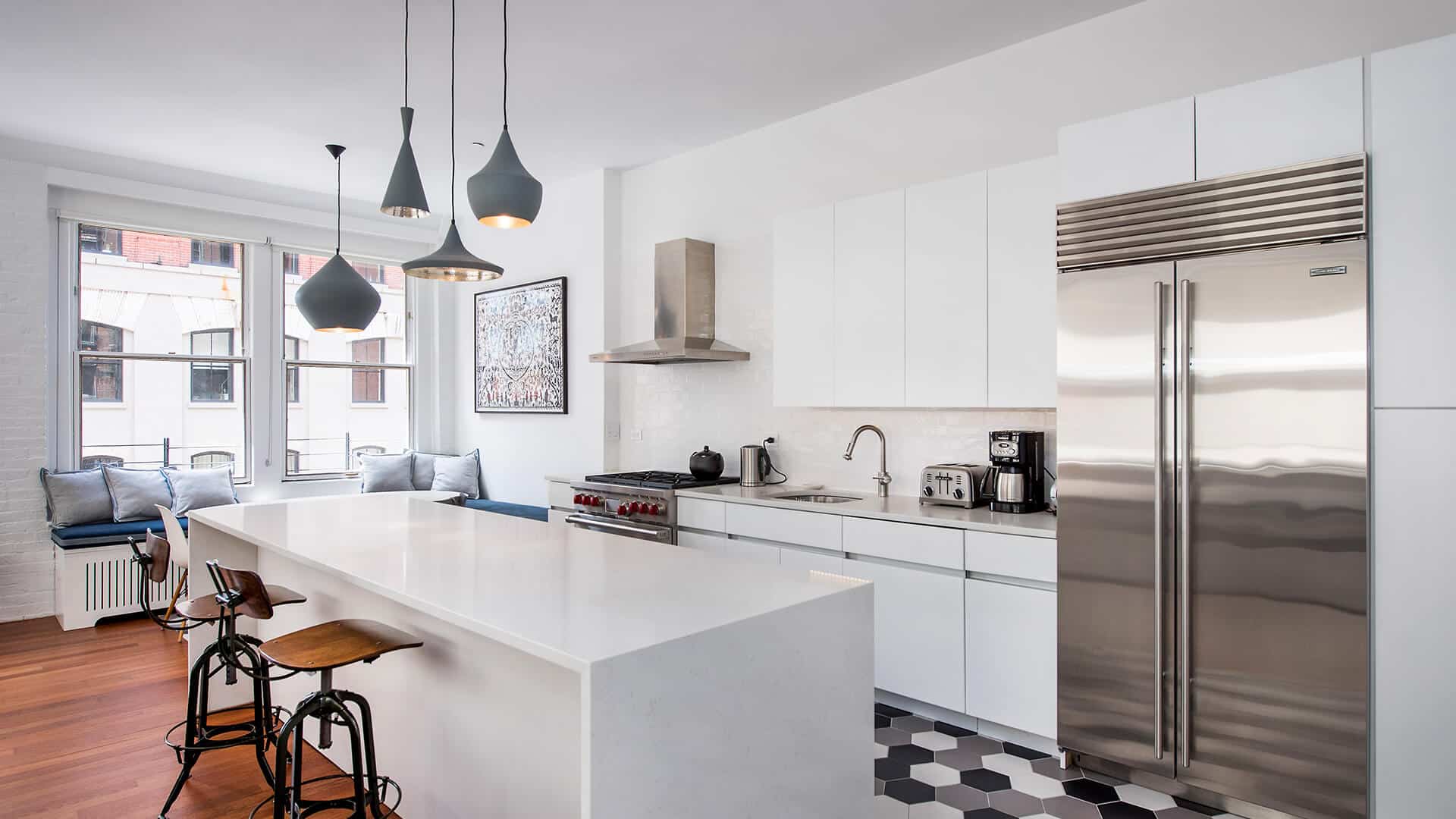Home Improvement
Manhattan Kitchen Renovation: Your Complete Guide

Manhattan kitchens face unique challenges that most homeowners never encounter. Space comes at a premium, building regulations can be complex, and costs often exceed national averages by significant margins. Yet these same constraints can inspire some of the most innovative and beautiful kitchen designs you’ll find anywhere.
Renovating a kitchen in Manhattan requires careful planning, smart design choices, and realistic budget expectations. This guide will walk you through every aspect of the process, from initial planning to final installation, helping you create a kitchen that maximizes both function and style within the unique constraints of Manhattan living.
Planning Your Manhattan Kitchen Renovation
Understanding Manhattan’s Unique Challenges
Manhattan apartments present distinct obstacles that affect every renovation decision. Most kitchens range from 50 to 120 square feet, compared to the national average of 200 square feet. This space limitation means every inch must serve multiple purposes.
Building age adds another layer of complexity. Many Manhattan buildings date back 50 to 100 years, with outdated plumbing and electrical systems that may require extensive updates. Pre-war buildings often have unusual layouts and structural elements that can’t be modified.
Co-op and condo boards impose additional restrictions. Most buildings require board approval for renovations, and some limit work hours to weekdays between 9 AM and 5 PM. These restrictions can extend project timelines and increase labor costs.
Setting Realistic Budget Expectations
Kitchen renovation in Manhattan typically cost 30-50% more than similar projects in other parts of the country. Several factors contribute to these elevated costs:
Labor rates reflect the high cost of living, with skilled contractors commanding premium prices. Material transportation and storage in dense urban areas add logistical expenses. Limited working hours due to building restrictions can extend project timelines and increase labor costs.
Budget ranges vary significantly based on scope and finishes. A basic refresh focusing on paint, hardware, and minor updates might cost $15,000 to $25,000. Mid-range renovations with new appliances, countertops, and cabinet refacing typically range from $40,000 to $70,000. High-end complete renovations can easily exceed $100,000.
Design Strategies for Small Manhattan Kitchens
Maximizing Vertical Space
Manhattan kitchens demand creative use of vertical space. Extending cabinets to the ceiling adds valuable storage while making rooms feel larger. Upper cabinets with glass fronts create visual depth without adding weight to the design.
Open shelving serves dual purposes, providing storage while maintaining an airy feel. However, use open shelving strategically—too much can make small spaces feel cluttered. Consider combining closed storage for everyday items with open shelving for decorative pieces.
Smart Storage Solutions
Effective storage solutions can double or triple a kitchen’s functional capacity. Pull-out drawers in base cabinets make deep spaces accessible. Lazy Susans maximize corner cabinet usage. Drawer dividers and organizers ensure every inch serves a purpose.
Consider unconventional storage locations. The space above the refrigerator can house items used less frequently. Magnetic strips on walls hold knives and spice containers. Rolling carts provide additional prep space and storage while remaining mobile.
Lighting Design for Small Spaces
Proper lighting can make small kitchens feel significantly larger. Layer different types of lighting to create depth and functionality. Under-cabinet lighting illuminates work surfaces while adding ambient glow. Pendant lights over islands or peninsulas provide task lighting and visual interest.
Natural light should be maximized whenever possible. Avoid heavy window treatments that block light. If privacy is needed, consider frosted glass or light-filtering shades that maintain brightness while providing coverage.
Navigating Building Regulations and Permits
Understanding Your Building’s Requirements
Each Manhattan building has specific renovation requirements. Co-op and condo boards typically require detailed plans, contractor credentials, and insurance documentation before approving projects. Some buildings maintain lists of approved contractors or require specific insurance coverage amounts.
Schedule board meetings well in advance. Most boards meet monthly, and missing a meeting can delay your project by weeks. Prepare thorough documentation including floor plans, material specifications, and timeline estimates.
Permit Requirements
Kitchen renovations often require permits from the Department of Buildings. Electrical work, plumbing changes, and structural modifications typically require permits. Even seemingly minor changes like moving a wall or adding outlets may need approval.
Work with contractors familiar with Manhattan permit processes. Experienced local contractors understand requirements and can often expedite approvals. DIY permit applications frequently face delays due to incomplete documentation or misunderstanding of requirements.
Managing Neighbor Relations
Close proximity to neighbors makes communication essential. Inform adjacent units about your renovation timeline and expected noise levels. Most Manhattan buildings have strict quiet hours, typically after 6 PM on weekdays and all day on weekends.
Consider offering small gestures of goodwill, such as gift cards for local restaurants, to neighbors most affected by construction noise. These small investments in relationships can prevent complaints and building management issues.
Selecting Contractors and Managing Projects
Finding the Right Contractor
Manhattan kitchen renovations require contractors with specific urban experience. Look for contractors who regularly work in your neighborhood and understand local building requirements. Check references from recent projects in similar buildings.
Verify all licenses and insurance coverage. Manhattan contractors should carry comprehensive liability insurance and workers’ compensation coverage. Some buildings require additional insurance naming the building as an additional insured party.
Managing Construction in Small Spaces
Limited space affects every aspect of construction. Materials must be staged carefully, often in small batches. Dust containment becomes critical in small apartments where cooking and living spaces connect directly.
Establish clear protocols for material delivery and storage. Many Manhattan buildings have specific delivery hours and requirements. Coordinate with building management to ensure smooth material flow and minimize disruption to other residents.
Timeline Management
Manhattan kitchen renovations typically take 6-12 weeks, longer than similar projects elsewhere. Building restrictions on working hours extend timelines. Permit approval processes can add weeks to project starts.
Plan for temporary cooking arrangements. Many Manhattan residents rely on delivery services, portable cooking appliances, or arrangements with neighbors during renovations. Consider timing renovations during seasons when outdoor dining is more appealing.
Appliance Selection for Manhattan Kitchens
Size Considerations
Standard appliances often don’t fit Manhattan kitchens. Measure all dimensions carefully, including clearances for doors and drawers. Consider apartment-sized appliances designed for urban living.
Counter-depth refrigerators provide full-size capacity while maintaining smooth kitchen lines. Compact dishwashers can fit in spaces too small for standard models. Combination appliances like microwave-convection ovens save valuable counter space.
Energy Efficiency
Energy-efficient appliances reduce utility costs in buildings where residents often pay their own utilities. Look for ENERGY STAR certified appliances that meet strict efficiency guidelines.
Induction cooktops offer precise temperature control while generating less heat than gas or electric alternatives. This benefit is particularly valuable in small spaces where excess heat can make kitchens uncomfortable.
Installation Considerations
Appliance installation in Manhattan requires special considerations. Elevator reservations may be needed for large appliances. Narrow hallways and doorways can prevent standard appliances from reaching apartments.
Measure all pathways from building entrance to final installation location. Include door frames, hallway widths, and elevator dimensions. Some appliances may require disassembly for installation in tight spaces.
Maximizing Your Investment
Choosing Timeless Design Elements
Manhattan real estate values reward classic design choices over trendy elements. Neutral color palettes appeal to broader audiences and age gracefully. Quality materials like natural stone and solid wood maintain value over time.
Invest in elements that are difficult to change later. Plumbing and electrical rough-in work, flooring, and built-in storage represent long-term investments. These elements are expensive to modify and significantly impact daily functionality.
Balancing Personal Style with Market Appeal
Manhattan apartments often serve as long-term investments. Balance personal preferences with broad market appeal. Bold design choices can be incorporated through easily changed elements like paint, hardware, and accessories.
Consider the building’s character when making design decisions. Modern finishes might feel out of place in a pre-war building with original details. Conversely, traditional elements might not suit a contemporary high-rise.
Maintenance and Longevity
Manhattan kitchens see intensive use due to space constraints. Choose materials and finishes that withstand heavy use. Quartz countertops resist stains and scratches better than natural stone. Semi-gloss paint on walls cleans more easily than flat finishes.
Plan for easy maintenance and repairs. Complex systems or specialized materials may be difficult to service in Manhattan’s dense urban environment. Choose reputable brands with local service networks.
Making Your Manhattan Kitchen Dreams Reality
Kitchen renovation in Manhattan requires patience, planning, and realistic expectations. The constraints of urban living can inspire creative solutions that maximize both function and beauty. Success depends on thorough preparation, skilled professionals, and clear communication with all parties involved.
Start your planning process early, allowing time for building approvals and permit processes. Research contractors thoroughly and check references from similar projects. Most importantly, remember that a well-planned Manhattan kitchen renovation can transform your daily life while adding significant value to your home.
The investment in a quality kitchen renovation pays dividends in daily satisfaction and long-term property value. With careful planning and execution, your Manhattan kitchen can become a beautiful, functional space that serves you well for years to come.
Contact Info:
Name : D2 Design and Works
Email: info@d2designandworks.com
Phone: (212) 873-7272
Website: https://www.d2designandworks.com/















